- Bernard Preston homepage
- Solar geek
- Solar Powered Generator Upgrade
Solar Powered Generator Upgrade
Solar powered generator upgrade can be unnecessarily expensive; do your planning properly and get it right the first time.
I saw this array in Holland; it is so simple to build on the ground but you notice it's in shade in the early morning. I would estimate about 5kW of panels.
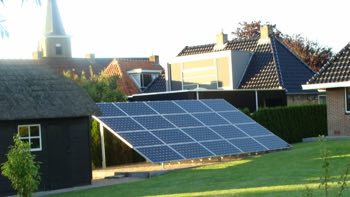
This page was last updated by Bernard Preston on 9th January, 2021.
So you already have photovoltaic panels, a regulator generally known as an MPPT, perhaps batteries and an inverter. You understand that the PVs turn photons of sunlight into usable direct current.
Generally in the urban area, those panels would be situated on your roof, though I recommend they be placed on the ground if there aren't trees about. Working in the ceiling and on the tiled or corrugated iron is difficult and potentially dangerous.
It can also mean leaks in the roof; and it is much easier to wash them on the ground. Dust and dirt drop the output.
Generally these panels would be facing south in the Northern hemisphere, but interestingly some authorities are recommending a few PVs be placed on a west-oriented roof, as much of the energy is needed in the late afternoon and early evening; and east too for the morning coffee.
It's an interesting thought. Is the good wife likely to have the electric oven or induction stove on at 4pm? If you had three large panels of around 500 watts that were directly absorbing the late afternoon sun, plus the same facing south, you could certainly cook using solar energy; in the summer at any rate.
We have now added 2,5kW of panels facing both east and west, five kilowatts in total. The next consideration is the effect of shadows on PV panels. Lower down you'll see we have an upgrade on that subject.
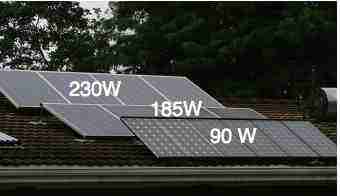
Well, that's now history; you see, your solar powered generator upgrade is likely to be a project in progress. We now have 3kW of west facing solar panels, and they are the most effective.
The next is east facing solar panels for the early morning sun, but I'm rather considering a movable string on the ground that I can turn manually for morning or afternoon light; the angle can be changed rather like that on a deckchair.
These mobile solar panels have been surprisingly successful supplying early morning and later afternoon power, and a boost when needed if the oven is needed for example.
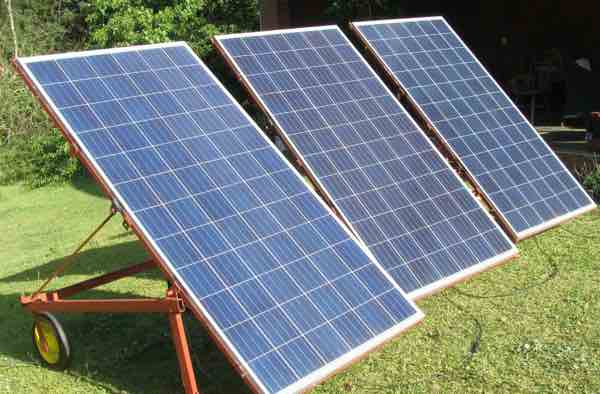
Solar Powered Generator Upgrade
Do not do it like this, if at all possible. Do your planning carefully from the beginning, and include the greed factor; you will want more of this free solar energy; otherwise your are certainly in for an unnecessarily expensive solar powered generator upgrade.
The energy is free; only collecting, storing and processing this electricity comes at a price.
Use of diodes means that you can use mismatched panels; although not recommended by the industry I have proved that it can work with no significant losses, or downside; it is not ideal though.
But if you haven't yet started, I would go straight to a minimum of twelve identical 300W, or larger, south facing panels, and three PVs oriented westwards. That would give you around 4kW which is an awful lot of energy; about six hundred kilowatt hours per month, depending on the weather and seasons.
Use the largest panels you can lay your hands on.
Because I didn't factor in human greed, my puny start with four 90W panels was in hindsight totally absurd. If you do it properly the first time, it hurts only once.
Now let's talk about the Maximum Power Point Tracker; it's a fancy regulator and a not inexpensive item at around one thousand dollars, depending on the size.
Again, my little 20 amp MPPT was absurd, and hence the need for this solar powered generator upgrade. My advice is to straight to a minimum of 60A; it's the most cost effective size. The industry seems to be suggesting two of these rather than one larger regulator. The Microcare MPPT charge controllers that I've been using have been top notch; they have given zero trouble.
MPPT
The MPPT increases the efficiency of your whole system; do your planning so you do not have to do a solar powered generator upgrade.
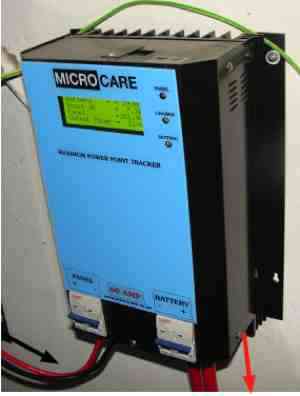
The Maximum Power Point Tracking controller regulates the charging of the batteries; without it, you would cook the cells if you went on holiday. Three to five kilowatts of PV panels will rapidly fill your capacity in the morning and then that energy needs to be managed; it is the job of the MPPT. Don't upgrade yours; go straight to 60 amps and then a second if you need it.
The MPPT tracks the most efficient combination of volts and amps coming from the PV panels for charging your batteries; it increases the output from the array by about 30 percent, depending on a huge number of factors. You can't do without it.
I have not questioned my guru but he recommends you don't do a solar powered generator upgrade to a 100A MPPT but rather two of these regulators should you want arrays facing different directions; as I have.
That I have done since the west facing solar panels have been added; they took me over sixty amps. Now we have enough energy to power up the oven, my electric lawnmower and even the thicknesser-planer in the workshop. They have provided the extra needed in the late afternoon.
There is one exception; west or east facing solar panels will be producing very different voltages in the early morning or late afternoon; they simply have to be on separate MPPTs.
For example you may have 3 x 545W = 1450 watts of west-facing panels. Divide by 48V and you'll get a maximum of 30.2 amps. The 20A MPPT would be adequate. I simply have no more space on that roof so I cannot upgrade further in any case.
MPPT upgrade
The decision to upgrade your solar system is never simple; it's costly and integrating with your existing hardware can provide a challenge.
Three factors are at work in our case.
- The deteriorating quality and availability from the utility. Lower down you will read of the massive surge that did so much damage to the whole street.
- The increase in price of power far beyond inflation.
- The greed factor; the more we appreciates that the sun continues to supply power, with no drop in quality and no increase in price, makes one desirous of more solar and less utility electricity.
So, the decision to add another 5kW of panels, and two large 100 amp MPPTs.
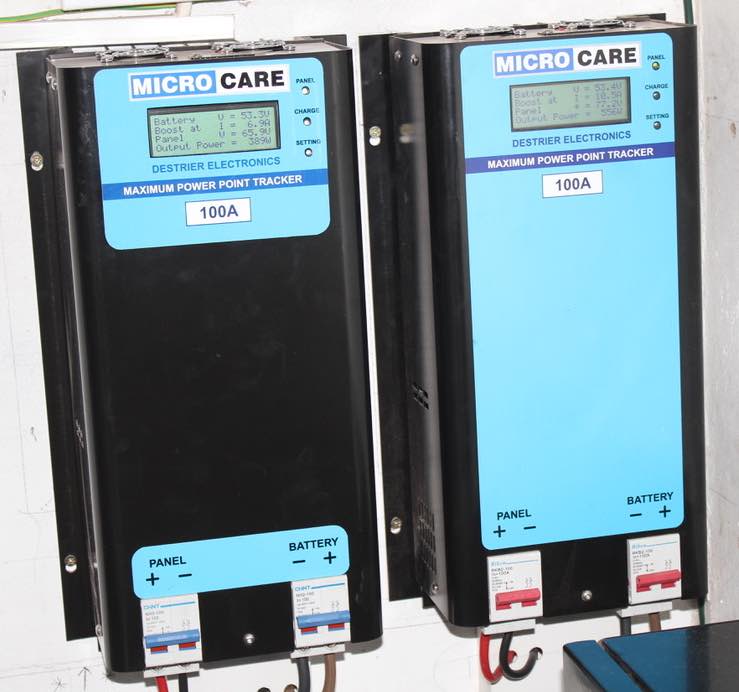
Voltage upgrade
A bit of physics is needed first. The power in watts delivered by your PV array is obtained by using this formula:
Power in watts = Volts x Amps
For example, 1000W could be 50V x 20A, or it could be 200V x 5A.
The heat loss in the cabling is determined by the amps, and not the V, and the resistance, so you want to make the current as low as possible. That means using a high voltage.
We do that by putting the PV panels in series to increase the voltage to the maximum the MPPT can handle; around 150V. Look at the specifications. My three 310W panels in series came in just below the maximum; one does need to take into account a voltage spike in very cold weather; actually having gone through this process of solar powered generator upgrade, I'm less concerned about that; the current would be very low.
More important, don't be tempted to go for a 12, or 24V system, but go straight to 48 volts. That means four batteries in
series. The higher the voltage, the lower the amps, and that means much smaller losses.
Don't do a solar power generator upgrade of voltage; yes, it costs quite a lot extra, but go straight to 48V.
It's much more efficient and, I promise you, you will upgrade later if you start with a 12 or 24V system. Remember, it hurts only once if you do it properly the first time.
That means four big expensive batteries, and a 48V MPPT and inverter from the start; do it. I didn't and it hurt far more to upgrade.
Inverter
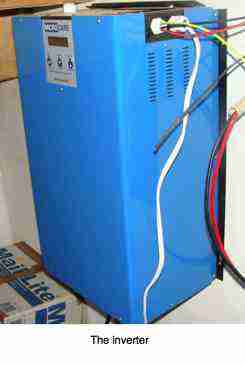
This inverter is the heart of the whole system; she takes direct current from the batteries, at 48V if you take my advice above, and turns it into 110V or 220V alternating current that you can now power straight into your distribution board; again, do your planning so you don't need to make an unnecessarily expensive solar powered generator upgrade.
It gives a wonderfully controlled voltage; no more spikes or brown-outs from the grid that can and do damage all the electronics in your home, at great expense. A surge has just blown the charger to my gate motor, so we've changed the remote gate controller entirely over to solar using one small local panel. Read how you can do that at residential solar panels.
It's another reason I've decided not to go with a grid-tied inverter; in our country there is so much dirty utility power that would damage my equipment.
Back to the inverter; don't mess around with the silly little 600W inverters; you just over stress them and they burn out in a short period.
Make a choice: 2kW, 5kW or 10kW. Definitely don't go smaller than 2kW, and my advice is to go straight to a 5kW inverter. It's expensive, but you won't regret it. I started with the 2kW and it was inadequate and I had to do another solar powered generator upgrade at considerable expense; I should have started with 5kW from the beginning, and so should you.
The 5kw inverter will easily handle a 2000W hot water kettle, the microwave, the breadmaker, several computers and an array of LED lights without shutting down. It's adequate for the average home. Also turn on the vacuum cleaner whilst the toaster is on, and you'll probably be fine; but you'll have a problem with the 3kW lawn mower.
So, I've upgraded yet again to the 10kw inverter and we have no more problems; of course extra batteries would be nice for when a cloud moves across the sun, but they are very expensive. Most of us do not have unlimited finance.
Greed
And now the final step of my solar powered generator upgrade, perhaps for you too, is to step up to the 10kW inverter. I've just done it. It's a very expensive and extremely heavy gadget; pure greed!

The crate that arrives weighs 130kg; that's heavy and takes at least four people to lift.
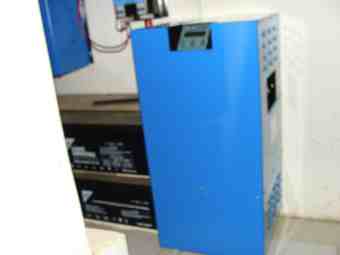
I've done this final solar powered generator upgrade only because we have two adjoining homes. It is certainly overkill for the average home unless you want to run aircons and have the total freedom to turn on whatever appliances you want without fear.
This baby will be used to power the swimming pool motor and chlorinator, the reservoir pump that supplies our home and the hot water kettles; two electric ovens and much more.
There's a down side to this solar powered generator upgrade; it uses some energy just to keep it activated, whether you are using power or not; about 100W.
It handles the large 3kw lawnmower beautifully but the sun must be shining. As a rule of thumb, if you have 10kW of panels as I have, try not to draw more than that amount for any length of time.
Battery bank
And you have to upgrade your battery bank. That's also expensive.
First having started with a 24V inverter, we had only two batteries.
Then moving to a 48 volt inverter which is more efficient, I had to upgrade to four lead batteries. They don't last very long and despite the expense I recommend going to lithium.
When you add batteries in parallel, you must make certain that they are within 0,2V of the first bank. Either you can charge the one bank, using a charger, or you can discharge the other.
But this means we almost have the capacity to go off the grid. Except that where we live we occasionally get three and even five continuous days of inclement weather; that would stress us out, so for the time being we remain connected to the utility.
Total cost is approaching $20,000. Anticipated
payback time is 5 to 7 years; it would be 4 years if we went off the grid,but that means the possibility of considerable inconvenience when the
weather turns ugly. This is more about convenience than trying to save
money.
More important in South Africa it means we have the guarantee of a continuous supply of clean electrical energy without the voltage fluctuations that do so much damage to the appliances in our homes. Just this week I had a patient who lost two fridges, a gate motor and her TV in one surge. Cost that into the equation and you have a payback time of 2 to 4 years.
And South Africa has outages every week; we have electricity when all the neighbours are fuming. That a problem that you probably only rarely have. When Hurricane Matthew and his pals arrive causing havoc!
Dirty power continues to arrive from the grid. 431V down our street was catastrophic.
Despite serious doubts, we are forced to consider going off the grid. That will mean an upgrade to either lithium or a Redflow battery. It's a big expense, but the utility is going to increase the cost of power by 20% in 2020; being completely independent is looking more attractive by the day.
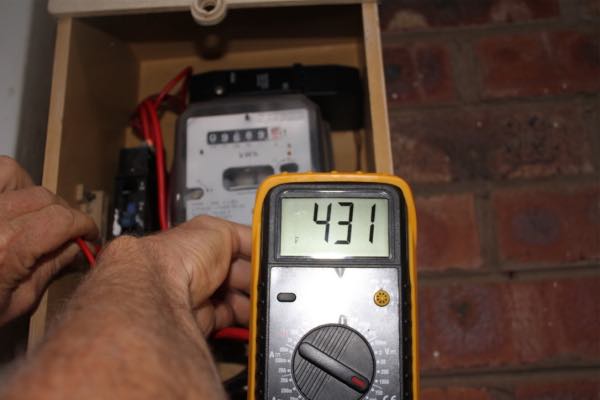
Battery upgrade
The price of lithium batteries has come down to such an extent that purchasing new lead type makes no sense.
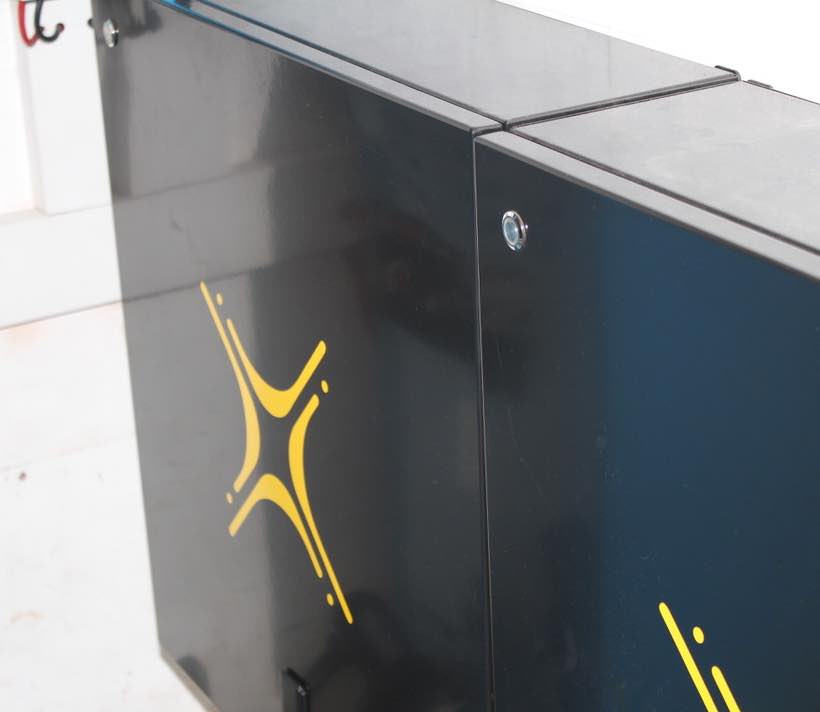
Just how much power?
It's interesting that in three and half years we have used 1706kwh of mains electricity. About 40 per month; just how much power can you draw from the grid?
Now that we have upgraded to the 10kVA inverter and have the oven on solar too, I expect it to drop to 30kWh per month.
Swimming pools are very greedy for power, using 1kw x 8 hours per day; 250kWh per month.
So all the excess power during the day doesn't go back to the grid; we sink it into keeping the solar swimming pool sparkling.
Safety
The battery room has some potentially dangerous components; an electrical fire is always a possibility. For safety sake every solar powered generator upgrade should include a smoke detector and an extinguisher.
In addition, a knifeblade fuse is an important feature limiting the amperage from the batteries in the event of a short circuit. I've decided to go with 130A, though that limits my inverter to about 7kW. I never go that high, even though the upgrade will provide 10.
Solar power energy
Solar power energy is free, but collecting and storing it is not inexpensive.
Do you home work and only install a 48V system, otherwise your solar powered generator upgrade is going to be unnecessarily costly.
The journey
As you realise solar powered generators have been a journey for us; we started long before there were competent people doing installations. Now we use almost no power from the grid and could dump the utility.
For you I recommend go big from the start; start saving for a solar farm.
Bernard Preston
Bernard Preston is a semi-retired DC with a background in physics; he did a BSc first, majoring in physics and chemistry, teaching high school science for seven years; hence he's able to write with some authority about the solar powered generator upgrade that he has made.
In his retirement he built a large solar farm to power their home when the South African utility began to fail due to poor planning; and retrenchment of their their highly trained white engineers.
They have decided to stay on the grid for the convenience but they use only 43kWh of electricity in the last three years; the rest comes from the sun.
Dr Preston suffered seriously from attention deficit as a child; fortunately in those days mind and behaviour altering drugs were not available. Having been told he would never pass high school mathematics he went on to complete two years at university, majoring in the tough sciences, physics and chemistry.
Attention deficit Bernie describes some of this struggle, declaring his deep concern that today we turn so easily, particularly for our children, to the cheap and nasty alternative of mind-altering Ritalin; it's a dangerous drug.
When browsing use right click and "Open Link in New Tab" or you may get a bad gateway signal.
Newsletter
Our newsletter is entitled "create a cyan zone" at your home, preserving both yourself and Mother Earth for future generations; and the family too, of course. We promise not to spam you with daily emails promoting various products. You may get an occasional nudge to buy one of my books.
Here are the back issues.
- Lifestyle and ideal body weight
- What are ultra-processed foods?
- Investing in long-term health
- Diseases from plastic exposure
- Intensive lifestyle management for obesity has limited value
- A world largely devoid of Parkinson's Disease
- The impact of friendly bacteria in the tum on the prevention of cancer
- There's a hole in the bucket
- Everyone is talking about weight loss drugs
- Pull the sweet tooth
- If you suffer from heartburn plant a susu
- Refined maize meal and stunting
- Should agriculture and industry get priority for water and electricity?
- Nature is calling
- Mill your own flour
- Bake your own sourdough bread
- Microplastics from our water
- Alternative types of water storage
- Wear your clothes out
- Comfort foods
- Create a bee-friendly environment
- Go to bed slightly hungry
- Keep bees
- Blue zone folk are religious
- Reduce plastic waste
- Family is important
- What can go in compost?
- Grow broad beans for longevity
- Harvest and store sunshine
- Blue zone exercise
- Harvest and store your rainwater
- Create a cyan zone at your home
Did you find this page interesting? How about forwarding it to a friendly book or food junkie? Better still, a social media tick would help.
- Bernard Preston homepage
- Solar geek
- Solar Powered Generator Upgrade
Address:
56 Groenekloof Rd,
Hilton, KZN
South Africa
Website:
https://www.bernard-preston.com